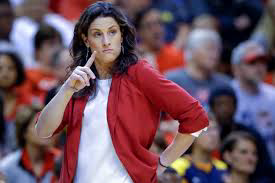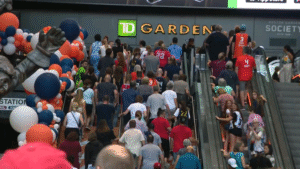
A Spectacular Night at TD Garden: The Fever vs. Sun Showdown
On the evening of July 15, a radiant energy filled TD Garden in Boston, as excited basketball fans packed the arena to capacity for a thrilling WNBA matchup between the Indiana Fever and the Connecticut Sun. This marked the second consecutive year that the Sun hosted a sell-out game in Boston—a testament to the surging popularity of women’s basketball in the region .

1. A Repeat of Last Year’s Triumph
Last summer’s historic WNBA debut in Boston—a regular-season game between the Connecticut Sun and Los Angeles Sparks—drew an impressive crowd of over 19,000 and created a vibrant “block party” atmosphere that took over Canal Street. Fans lined the streets, filled nearby venues, and celebated the significance of women’s athletics in a major-market venue .
That triumph set the stage for round two in 2025. The Sun returned to TD Garden with high expectations that this year’s matchup—this time against the Fever—would match or eclipse the buzz and attendance of the inaugural game .
2. Team Logistics: More Than Just a Game
Organizing a WNBA contest in a different state isn’t trivial. For this event, the Sun meticulously transported their entire home-court setup—bringing both the Mohegan Sun Arena court and equipment like rally towels and the Blaze mascot costumes to Boston. Over 20,000 orange towels were placed on seats to create a home-court visual, and a team of 60 staff and contractors handled the on-site preparations .
TD Garden’s operator, Glen Thornborough, expressed pride in again hosting such a charged women’s basketball event, noting that the enthusiastic turnout reflected a growing fanbase that demands attention .
3. More Than Just Caitlin Clark’s Hype
While national stars like Caitlin Clark of the Indiana Fever helped generate excitement—earning the nickname the “Caitlin Clark Effect”—local figures also played a huge role in drawing spectators. Here are two compelling reasons for the crowded arena:
Caitlin Clark Effect: Since being drafted, Clark has dramatically lifted Fever attendance and heightened interest in WNBA broadcasts, making any game she partakes in a national event .
Aliyah Boston’s Home State Return: Indiana’s star forward, Aliyah Boston, hails from Massachusetts (though born in St. Thomas, she attended Worcester Academy). Boston was celebrated with a ceremony at the Massachusetts State House where Governor Healey proclaimed July 15 “Aliyah Boston Day.” Her return to New England added emotional and regional significance .
The convergence of Clark’s growing star power and Boston’s homecoming gave this game a rare dual-generational and cross-team appeal.
4. Game-Day Experience and Atmosphere
Hours ahead of the tip-off, TD Garden’s Canal Street was abuzz with fan activity. A lively “block party” unfolded from late afternoon, featuring DJs, fan zones, giveaways, a merchandise truck, and appearances by Sun executives. Sponsors organized engagement activities and recorded a palpable pre-game energy .
Inside the arena, the setup reinforced Connecticut’s identity. Every seat featured an orange rally towel, and local vendors stocked Sun-branded gear. However, certain promotional elements—like a T-shirt cannon—were omitted due to TD Garden’s existing digital signage setup .
5. Teams in Contrast: A Tale of Two Seasons
The contrast between the two teams could not have been sharper heading into the game:
Connecticut Sun: Coming off a 3–18 season, the Sun struggled on the court. The franchise went through a rebuild, parting ways with all five starters and hiring a new head coach, Rachid Meziane. Ownership under the Mohegan Tribe also faces uncertainty as it evaluates future investment—it might sell, relocate, or bring in co-investors .
Despite their poor record, the Boston match provided a bright moment—a beacon of hope amid a difficult year .
Indiana Fever: In contrast, the Fever were enjoying mid-season form, riding an 11–10 record and coming off a 102–82 demolition of the Dallas Wings. Anchored by Caitlin Clark (despite some injuries), alumna Kelsey Mitchell, and standout Aliyah Boston (averaging 16.2 PPG, 8.1 RPG), the Fever had become a formidable force .
This contrast between thriving and struggling teams created a narrative of competitive hope against a backdrop of genuine adversity.
6. The Broader Impact and Stakes
This event wasn’t just another date on the schedule—it was a statement.
Local Favorites Making a Case: For Boston, this sold-out event added weight to discussions about potentially securing a permanent WNBA franchise. Players and analysts voiced that Boston has the fan base and enthusiasm to support a local team .
Television Spotlight: Unlike the inaugural game, this contest was nationally televised on ESPN—underscoring the growing centrality of women’s basketball in mainstream sports coverage .
Cup for Women’s Sports: Sponsors like TD Bank formalized partnerships with the team and the filed, supporting fan transportation and ticket accessibility. These arrangements recognized the importance of equity in sports and the rising investment in women’s athletics .
7. Community Connect: Pre-Game Events
The Sun embraced Boston’s local community with a multi-day engagement program leading up to the match:
Youth Sports Festival: Held at the Reggie Lewis Center, targeting 8–14-year-olds with clinics and skill-honing sessions.
Watch Party: A communal viewing event at Causeway Street allowed fans to gather ahead of the game with food, activations, and camaraderie.
Canal Street Block Party: Held right before tip-off, this street festival included community awards, DJ sets, giveaways, vendor booths, sunface painting, and a merchandise pop‑up .
These engagement activities fostered connection and extended the arena’s energy into the city’s streets.
8. The Game Tonight (7/15/2025)
At 8 p.m. ET, the lights shone bright on TD Garden as Sky Blue and Orange merged across the stands, representing both Connecticut and Indiana fans. National broadcasters tuned in—and the energy lay poised to match that from last year.
For Connecticut, it was about reaffirming its regional relevance and reigniting its fan community; for Indiana, it was a step toward playoff positioning and solidifying its national impact. Many fans wore Fever jerseys (especially Clark’s #22), while others proudly displayed Sun orange. The crowd’s turnout across the board—Sun and Fever supporters alike—reflected a deeper appetite for women’s basketball across demographics and geography .
Closing Thoughts
The sold-out affair between the Fever and Sun at TD Garden represented far more than a regular-season tilt. It showcased the surging cultural stature of women’s basketball in America, revealing:
The Caitlin Clark Effect: her arrival has broken attendance and viewership records for Fever games .
The power of local rooting: Aliyah Boston’s return celebrated regional pride in a major arena, further stimulating ticket demand .
The impact of strategic engagement: orchestrated community events, stadium logistics, and sponsor partnerships—especially from TD Bank—highlighted a growing ecosystem supporting the women’s game .
The potential for market expansion: a second consecutive sell‑out and glowing local coverage renewed momentum toward establishing a permanent WNBA franchise in Boston .
As tip-off neared, the atmosphere inside TD Garden felt electric, vibrant, and historic—an arena alive with chants, welcoming both teams and fans, and embodying a new era for women’s sports.
Leave a Reply